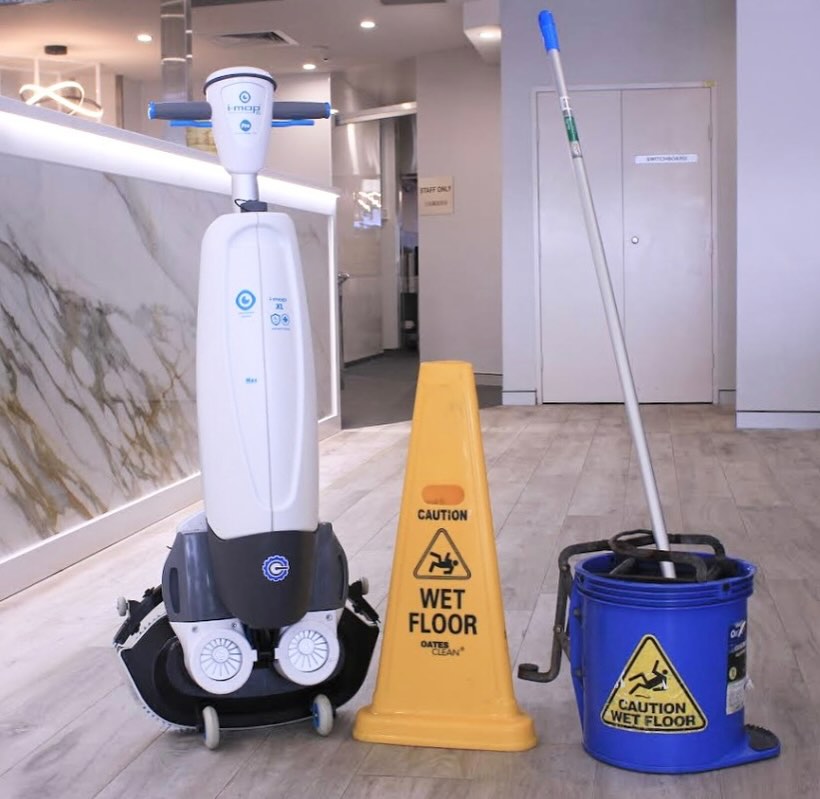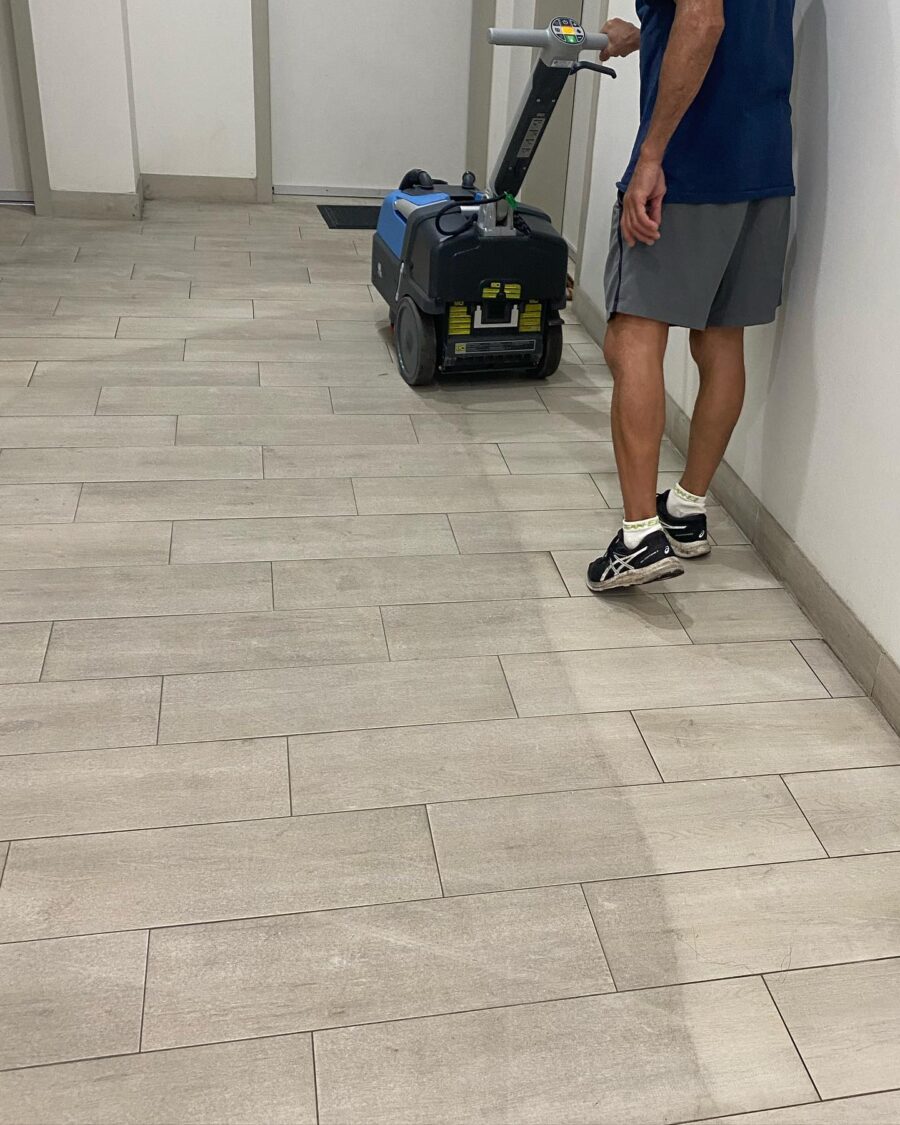Whether a business owner or a commercial building manager, you undoubtedly know the importance of clean floors for a smooth operation and a spotless presentation of your business in front of clients, investors, visitors, and employees. Sticky sodas and greasy drips on floors go beyond making a poor customer impression – they also create a safety hazard for everyone passing by. Even low-traffic floor areas can accumulate a surprising amount of dirt and grime you can’t easily remove with a mop (don’t get me started on break rooms).
Luckily, the cleaning machine industry has drastically grown in the last few decades, providing sophisticated floor cleaners such as scrubber dryers as a decent replacement for the bucket-mop combo. Motorised and user-friendly walk-behind floor scrubber dryers can effectively clean big floor areas, combining the tasks of traditional mopping and drying to ensure a clean in a single pass.
What Are the Benefits of a Walk Behind Scrubber?

An outstanding level of cleanliness, dry and safe floors, and enhanced productivity are the main reasons you should replace the mop with an efficient walk-behind scrubber dryer.
Dry and Safe Floors
When you use a mop to clean the floors, they stay wet for some time. Regardless of whether the space is a high- or low-traffic area, wet floors are always a safety hazard, causing passing people to slip and fall. Slip-and-fall related lawsuits cost businesses millions of dollars yearly. You can prevent all that by using floor scrubber dryers, as they entirely suck up all the dirty water, leaving floors clean, safe and dry.
Improved Efficiency
If you think comparing a machine with a mop is ungrateful, let’s compare it with other cleaning machines for hard floors. You can use a pressure washer in some situations, such as food factories. But, compared to manual cleaning, it’ll leave the floor much more damp, increasing the risk to health, safety, and downtime because the floor area can’t be used until it has dried. You can use a scrubber to clean and mop up the surplus water after pressure washing the walls and machinery, keeping downtime to a minimum.
Although floor sweepers work well for industrial floor cleaning and are great for removing dust and debris, you might need to scrub depending on the kind of grime. Certain machines can sweep, cleanse, and dry all in one go.
Happy and Productive Employees
Employees aren’t as quick with a mop and bucket, regardless of how rapidly someone cleans. More time might be spent providing a deeper cleaning in other parts of a business instead of emptying dirty water and wringing out filthy mops. And most employees are, let’s face it, far happier operating a machine than swiping a mop.
Moreover, cleaning, especially floor cleaning, can be labour-intensive. Therefore, current walk-behind scrubber dryers have ergonomic designs and hand controls, resulting in less operator fatigue and more effective operation. Additionally, driverless cleaning machines— software-driven and autonomous—are also in development. These devices will guarantee effective cleaning.
What to Consider When Choosing a Walk-behind Floor Scrubber?

Size and manoeuvrability, power source, tank capacity, brush type and pressure, ease of use and maintenance are all important factors in choosing the right walk-behind scrubber dryer.
Size and Manoeuvrability
You should consider the layout and scale of the area that needs to be cleaned to select the right size scrubber. If you have expansive, open spaces, opt for a larger cleaning path width to help reduce cleaning time. Smaller models with narrower paths are ideal for areas with tight corners, obstacles, and narrow aisles. Additionally, consider the machine’s turning radius—high manoeuvrability will help it more easily navigate crowded or complex environments.
Power Source
Walk-behind scrubber dryers come in battery-powered and corded models. Battery-powered units offer freedom of movement without being restricted by cords, making them perfect for larger or heavily trafficked areas.
However, check the battery life and charging times to meet your operational needs. Corded models, while limited by the length of the cord, provide continuous power without the downtime required for recharging, making them suitable for smaller areas or consistent, uninterrupted cleaning sessions.
Tank Capacity
The recovery and solution tank size affects refilling or emptying frequency during use. Larger tanks allow for extended cleaning sessions, reducing interruptions but add to the machine’s overall weight, making it harder to manoeuvre. Smaller tanks are lighter and easier to handle but require more frequent refilling. Balancing tank size with the practicality of handling is key, especially in larger facilities.
Brush Type and Pressure
Scrubber dryers typically use disk or cylindrical brushes, each suited to different floor types. Disk brushes are generally better for smooth, flat surfaces, providing excellent scrubbing power for general cleaning tasks. Cylindrical brushes are more effective on uneven surfaces and for picking up small debris, acting almost like a vacuum. Adjustable brush pressure is also an advantage, allowing you to tailor the scrubbing intensity based on the type of dirt and floor material.
Ease of Use and Maintenance
User-friendly machines with intuitive controls can significantly reduce the time required for operator training and improve overall efficiency. Look for models with simple, clear displays and controls that are easy to understand. Regular maintenance is inevitable, so machines that offer easy access to parts like brushes, tanks, and filters will save time and reduce downtime, keeping the scrubber running smoothly and effectively



